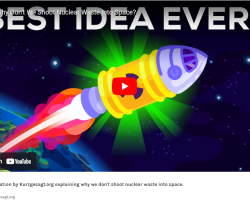Category of Content
Siting Experience Documents Only
Publication Date
Subject Matter
Mothers for Nuclear Flyer
Mothers for Nuclear Flyer
Mothers for Nuclear Informational Flyer
Guidance for Creating a Community Benefits Plan for Regional Direct Air Capture Hubs
Guidance for Creating a Community Benefits Plan for Regional Direct Air Capture Hubs
This document is intended to provide supplemental information to assist applicants developing a Community Benefits Plan (CBP) for the Regional Direct Air Capture Hubs. As shown in the graphic to the right, Community Benefits Plans are based on a set of four core interdependent policy priorities: engaging communities and labor; investing in America's workforce; advancing diversity, equity, inclusion, and accessibility; and implementing Justice40.
The Social and Ethical Aspects of Nuclear Waste
The Social and Ethical Aspects of Nuclear Waste
Nuclear waste management seems to exist in a perpetual state of crises. For 50 years the nuclear states of the world have fought, and generally lost, the battle to deal with the nuclear waste problem. Worldwide, there is a growing acknowledgement within industry and government that social and ethical issues are just as important as technical issues when developing safe programs for nuclear waste management. This paper is a review of some of the outstanding social and ethical issues that are influencing discussions on nuclear waste management around the world.
Policies for Achieving Energy Justice in Society: Best Practices for Applying Solar Energy Technologies to Low-Income Housing
Policies for Achieving Energy Justice in Society: Best Practices for Applying Solar Energy Technologies to Low-Income Housing
Studies indicate that the energy burden — energy costs as a percentage of annual family income — on low-income families is inordinately high, compared to that of the rest of the population. Rising fuel costs exacerbate this problem. Residential solar energy systems can help address this situation by furnishing a price-stable energy source with the added benefit of reduced greenhouse gas emissions. However, without appropriate incentives, these systems are prohibitively expensive for low-income families.
Science based responses to social myths on nuclear energy
Science based responses to social myths on nuclear energy
In order to promote a sound basis for considering the role of nuclear in climate change, this review spans the technical topics of social and political debate surrounding nuclear energy with a focus on the objective science of these issues including nuclear waste, accidents and overall risk. Novel aspects include the emergence of nuclear energy as being potentially renewable and the antithesis of Fukushima being an argument for the unacceptable risks associated with the use of nuclear energy.
Survey of National Programs for Managing High-Level Radioactive Waste and Spent Nuclear Fuel: 2022 Update
Survey of National Programs for Managing High-Level Radioactive Waste and Spent Nuclear Fuel: 2022 Update
In October 2009, the U.S. Nuclear Waste Technical Review Board (Board or NWTRB) published Survey of National Programs for Managing High-Level Radioactive Waste and Spent Nuclear Fuel. For each of the 13 national programs studied, the report catalogued 15 institutional arrangements that had been set in place and 15 technical approaches that had been taken to design repository systems for the long-term management of high-activity radioactive waste.
Summary of Consolidated Interim Storage Advantages and Disadvantages from an Integrated Systems Perspective from Prior Reports and Studies
Summary of Consolidated Interim Storage Advantages and Disadvantages from an Integrated Systems Perspective from Prior Reports and Studies
The question of whether centralized storage of civilian spent nuclear fuel (SNF) should be part of the federal waste management system as an intermediate step before permanent disposal has been debated for more than four decades. Centralized storage facilities were included as a potential component of the U.S. spent fuel management system in the Nuclear Waste Policy Act of 1982 (NWPA), but the NWPA did not identify these facilities as being essential.
3 Reasons Why We Don’t Launch Nuclear Waste into Space
3 Reasons Why We Don’t Launch Nuclear Waste into Space
A viral YouTube video recently discussed the age-old question “why don’t we shoot nuclear waste into space?”
It’s a topic we often get asked about on social media.
While the educational video’s cartoonish depictions of nuclear waste as glowing green ooze made some of our subject matter experts cringe, it’s clear that the content creators did their homework.
Status and Trends in Spent Fuel and Radioactive Waste Management
Status and Trends in Spent Fuel and Radioactive Waste Management
Status and Trends in Spent Fuel and Radioactive Waste Management is a collaborative project between the IAEA, the European Commission and the OECD Nuclear Energy Agency, with the participation of nuclear industry organization the World Nuclear Association, that aims to consolidate and complement the information gathered from different initiatives around the world.
Disposition of High-Level Waste and Spent Nuclear Fuel: The Continuing Societal and Technical Challenges
Disposition of High-Level Waste and Spent Nuclear Fuel: The Continuing Societal and Technical Challenges
There has been, for decades, a worldwide consensus in the nuclear technical community for disposal through geological isolation of high-level waste (HLW), including spent nuclear fuel (SNF). However, none of the national programs established to implement geological disposal has yet succeeded in establishing a geological repository and emplacing HLW in it. The large and growing HLW inventory from civilian and military reactor use over nearly 60 years remains in surface facilities intended only for interim storage.






